#lachish
Explore tagged Tumblr posts
Text
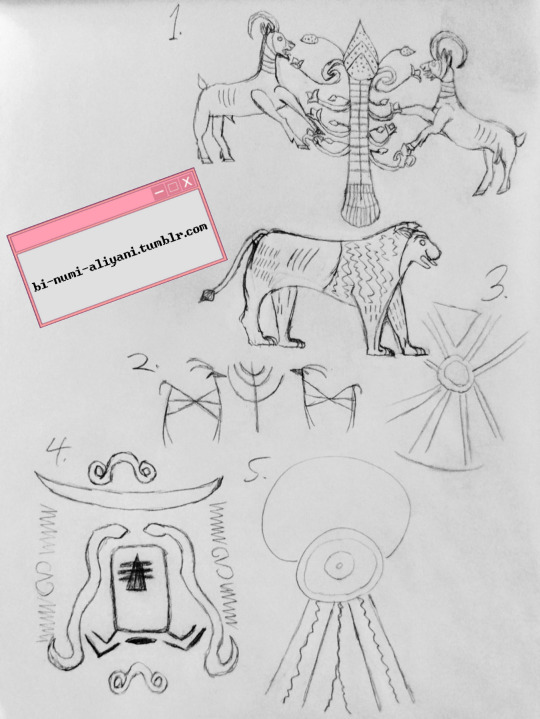






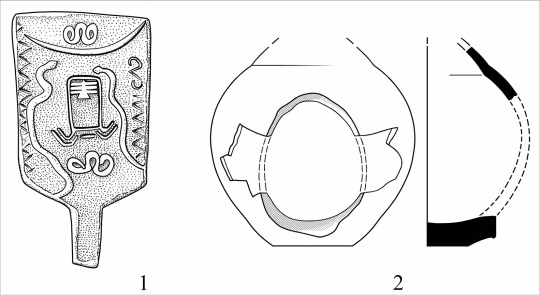


Hello, friends! I apologize for my absence as of late, I unfortunately ended up in a situation where I didn't have access to the internet for a little while and had to get everything sorted out. There's a lot of things I'm excited to do here, but for now I'd just like to hopefully make up for it with these sketches of ancient symbols of 𒀭El-Elyon and 𒀭Lady Ashirat :)
Great Seal of 𒀭Ashirat: This is the Asherah-tree symbol as it appears on the famous Pithos A from the Kuntillet Ajrud site. It probably came from around the early 8th century BCE when the former Judean outpost was under Northern Israelite control and bears a now-famous inscription mentioning “𒀭Yahweh of Samaria and His 𒀭Asherah.” The ornately-depicted Sacred Tree nourishes two flanking ibex, the sacred animal of 𒀭Ashirat, and rests above a lion which symbolizes a Deity's strength in ancient Canaanite iconography.
Small Seal of 𒀭Ashirat: This more simplistic iteration of the Tree-and-Ibex symbol is found on the famous Lachish ewer from the end of the Bronze Age and is most notable for its remarkable resemblance to the Menorah of the later Temple of 𒀭Yahweh at Jerusalem.
Small Solar Seal of 𒀭El: This design is found on the head of a sceptre held by a bronze seated figurine of 𒀭El in intact gold leaf from a Bronze-Age Temple at Megiddo (Tel Megiddo). It was made around the same time as the Lachish ewer and is believed to invoke the Sun and its beams in a similar way to more recognizable Egyptian or Mesopotamian solar symbols. Another theory holds that it depicts a flower.
Seal of the House of 𒀭El: Yet another 13th century BCE find, this peculiar insignia is featured on a bronze sceptre head coated in silver leaf which would have been inserted into a wooden pole to be grasped by a life-sized cult statue of 𒀭El. A stylized human face is flanked by serpents and zigzag lines topped with an upturned crescent. At the bottom and the top is another sign resembling the omega-shaped womb symbol originally associated with the Mother Goddess 𒀭Ninhursag of the Sumerian Pantheon (cf. the cow uterus headdress of the ancient Egyptian childbirth Goddess 𒀭Meskhenet and the “Hathoric curls” hairstyle associated with 𒀭Lady Ashtart and 𒀭Qadesh). This design was described as a “cult standard” by the archaeological team who discovered it in a destruction layer at Hazor (Tel Hazor) in the 1950s and I've interpreted it to symbolize the House of 𒀭El which is also the House of all the Gods and Goddesses. The artifact was found in what appeared to be a small shrine indicating it possibly received some kind of veneration of its own.
Great Solar Seal of 𒀭El: This is from another bronze sceptre head with silver leaf and was discovered in a 12th century BCE layer at the site of a Canaanite Temple in Lachish (Tell ed-Duweir). I've followed the interpretation that this is a solar symbol similar to the one from Megiddo. A solar disc with three nesting circles is backed by a sort of oblong "halo" which represents the Firmament of Heaven in my view. The Sun with its life-giving rays shown descending upon the Earth here has been interpreted as an anthropomorphic figure as well. I can also see the broad outer bands and the thin inner streams having to do with 𒀭El's Abode of Mount Lalu being located “at the Source of the Two Rivers, at the Confluence of the Channels of the Two Deeps” according to Ugaritic texts.
Thanks so much for checking this out!
My source for the pictures of and information on the 𒀭El sceptres is “The sceptres of life-sized divine statues from Canaanite Lachish and Hazor” by Yosef Garfinkel in Antiquity 94:375 (2020), pp. 669–685, https://doi.org/10.15184/aqy.2020.44.
#pagan#paganism#semitic pagan#semitic paganism#polytheism#polytheist#canaanite polytheism#canaanite paganism#canaan#canaanite#el#athirat#asherah#bronze age#late Bronze age#ancient near east#history#ancient history#religion#faith#spirituality#gods#mother goddess#sacred tree#ancient levant#archaeology#lachish#hazor#kuntillet ajrud#megiddo
11 notes
·
View notes
Text
youtube
The Lachish Reliefs document the Assyrian victory over the Kingdom of Judah during the Siege of Lachish in 701 BC. The Lachish Reliefs, documenting this event, reside in the British Museum in London.
#WalktheBible#TelLachish#LachishReliefs#Lachish#Israel#BritishMuseum#London#Assyrian#SiegeofLachish#IsraelsLastStand#VisitIsrael#holyland#Archaeology#BibleArchaeology#BiblicalArchaeology#ChristianPilgrimage#ChristianTraveller#DiscoverIsrael#Jesus#History#AncientHistory#bibletravel#christiantravel#PaulBackholer#MaryBackholer#Backholer#MathewBackholer#WalkIsrael#WalkLondon#LondonMuseum
2 notes
·
View notes
Text
Battles
Joshua 10:29-33. Then Joshua passed from Makkedah, and all Israel with him, unto Libnah, and fought against Libnah: And the LORD delivered it also, and the king thereof, into the hand of Israel; and he smote it with the edge of the sword, and all the souls that were therein; he let none remain in it; but did unto the king thereof as he did unto the king of Jericho. And Joshua passed from…

View On WordPress
#Battles#complete destruction#Gezer#heavy burden for Joshua#Joshua 10:29-33#Lachish#Libnah#Makkedah#my own ponderings#no one left alive
0 notes
Photo

Assyrian archers firing on the enemy during the siege of Lachish. Each archer was protected from enemy fire by a shield bearer. The pointy pattern in the background means that this scene is happening in the mountains. They represent the army of King Sennacherib of Assyria (reigned 705-681 BCE) marching on Lachish, an ancient town about 40 km from Jerusalem. This image is part of a series of reliefs...
167 notes
·
View notes
Text
Jewish Life Pre-Diaspora: Women's Hair
back in april @mylight-png made a post expressing a desire to learn about small details of "ancient Judean" life such as clothes, jewelry, hair, etc. and I've found the idea of addressing what I, as a Jewish archaeologist, could in that post intriguing. these types of questions are some of the most interesting, but also the most challenging, for archaeology.
Defining "ancient Judeans"
In this, I'm looking for ancient Judeans as defined by Light's quote "I wish to know what traditional, pre-occupation, pre-exile Jewish life was like." which I'm taking as before the babylonian diaspora in 586 BCE, because anything after that date is post-diaspora, and while there were occupations before 586 BCE, I want to be able to give some answers.
Women's Hair
The only definitive visual depiction of Judean women I could find came from the Lachish Relief, a wall decoration in Sennacherib's Southwest Palace in Nineveh, which is in modern-day Iraq. It depicts the outcome of the siege of Lachish in 701 BCE, where the Assyrians sacked the Judean city as a part of Sennacherib's campaigns into Israel and Judah (the same campaign that led to the diaspora of the 'ten lost tribes')
In the relief, women are displayed as wearing long headscarves (below) so unfortunately this tells us little about their hair (in the relief, children are shown as miniaturized adults, so we also learn nothing about girls hair from the relief).
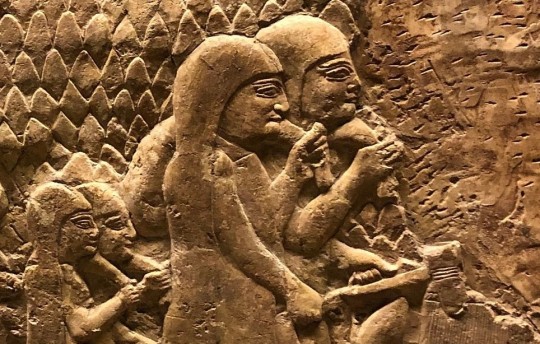
(Image credit: Amanda Borschel-Dan/Times of Israel)
Hope for learning anything about women's hair isn't lost though, thanks to a type of artifact called a Judean Pillar Figurine (or JPF's for short). These figurines are split into two groups: those using well detailed molds, and handmade, more abstract pieces.
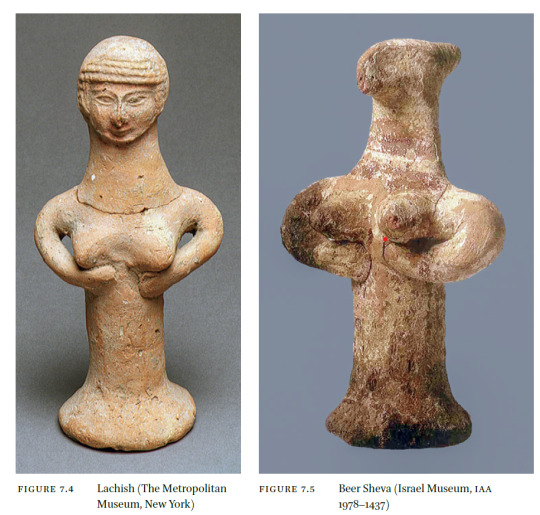
(Deutsch, 2022)
Hundreds of JPF's have been found, with over 50% of them coming from the Jerusalem area and all dating to the 9th-6th centuries BCE, which is the time period we're looking for. The primary issue is that we don't know what exactly they were used for, or who they represent. They could be depictions of Judean women, but it's also likely that they are depictions of Ashera, a local fertility deity that was worshiped alongside El/Hashem in domestic settings (religion in pre-diaspora Israel and Judah is messy, I should probably do one of these about it), and it's even been theorized that they are children's toys. The two types may even be used differently, we just don't know. So while I'm going to show the JPF hairstyles, keep in mind that these may not be the actual hairstyles Judean women wore.
The mold-made faces consistently have "voluminous cheek- or chin-length hair framing a face with full cheeks, a mouth that may smile slightly, a chin, nose, and almond-shaped eyes." (Ben-Shlomo and McCormick 2021, 27, image below from the same, 29).
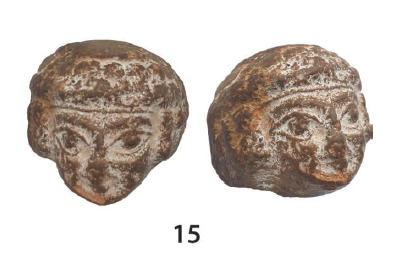
This hairstyle is seen in the area as early as the 12th century BCE, on an ivory flask "bottle figure" from Lachish, which is pre-Israelite, so this hairstyle has been in the region for a while. (Niditch 2008, 44), and may resemble an Egyptian wig in its form, owing to Egypt's cultural influence over Canaanite and early Israelite culture (Deutsch 2022).
This consistency and longevity in the features is also used as an argument that they represent a single individual (again, Ashera), rather than this hairstyle being ubiquitous among Judean women.
Among the handmade, pinched face JPF's, there is naturally more variety, and a possible hairstyle can be seen in them from Tell en-Nasbeh. Some of these handmade JPF's have a headband that has two side locks coming from underneath it (below), and while none displayed side locks without a headband, the reverse isn't true, though exceptionally rare (2 of the 37 JPF's found had a headband without hair).

(Ben-Shlomo and McCormick 2021, 29)
Conclusion
Due to the undetermined nature of the JPFs, and the lack of other evidence at the moment, it's impossible to definitively say "this is how ancient Judean women styled their hair." That being said, I hope I've presented some current ideas from my field that are interesting, and shed a little light on such an ephemeral topic.
TLDR: I couldn't find much, but there is ongoing research into this topic in archaeology.
27 notes
·
View notes
Text
Pillar figurine—Lachish, Judah (now Israel/Palestine), 8th to 7th century BCE

According to the Met: "This type of pillar figurine is typical of those produced in great numbers in the kingdom of Judah at this time. Tell el-Duweir is ancient Lachish, the major fortified center in Judah that was destroyed by the Assyrian army under Sennacherib (701 B.C.). The city's fate is chronicled in the Bible and represented in wall reliefs from the Assyrian palace at Nineveh. This buxom goddess figurine with pillar base is nude and supports her breasts in her hands. The head is simply rendered with a short, tightly curled caplike hairdo articulated in ridges, and the facial features are mold-made and clearly articulated. This imagery and that on clay plaques with nude female figures probably represents fertility or mother goddesses. The figurines are found in domestic contexts and point to popular cults that coexisted with monotheistic Judaism. Outside influences are evident in the religion of ancient Israel and Judah at this time, and Syrian cults focusing on the worship of Asherah may have been an influence. Asherah was the wife of El, head of the Canaanite pantheon, and probably the mother of the gods in Canaanite and later Jewish tradition. Some literary evidence in ancient Israel even speaks of Asherah as the consort of Hashem [the Met includes the tetragrammaton here] himself."
Here are some other female figurines in the Met's collection that use similar poses and come from surrounding areas.

This statue from northwestern Iran in the early first millennium BCE.

^ This Mesopotamian or Syrian figure from much earlier, around 5600-5000 BCE.

^ This Neo-Elamite part of a vessel from Southwestern Iran around the same time as the Judean Pillar Statues (8th-7th century BCE).

Another vessel in the shape of a woman from Northwestern Iran, also around the time of the Judean Pillar Statues (9th-7th century BCE).
#judean pillar statues#jewish history#ancient art#ancient history#jewish#jewish art#israel#israel/palestine#iran#ancient iran#mesopotamia#judah#ancient syria
16 notes
·
View notes
Text
By MELANIE LIDMAN
A network of fortified cities around Jerusalem has been dated to the time of King David, more than 200 years earlier than previously thought, offering support to the theory that King David ruled over a complex and large kingdom. The proof, however, wasn’t freshly excavated from the earth, but rather came to light after an archaeologist spent years digging through old archaeological publications.
In a new academic paper, Prof. Yosef Garfinkel of the Institute of Archaeology at Hebrew University claims he has found evidence of urban settlement in organized cities dating to around 1,000 BCE, during the reign of King David.
His article, published Monday in the Jerusalem Journal of Archaeology, a peer-reviewed publication of Hebrew University, supports the theory that King David ruled over a well-developed kingdom, complete with roads connecting between cities. This runs counter to the belief of some scholars from the minimalist school of thought who have previously suggested that since there is scant evidence of cities during King David’s reign, his position as a ruler of a great kingdom as written in the Bible could be exaggerated.
“What is a kingdom?” countered Garfinkel. “You need cities and roads and military power and economic power and writing.”
Garfinkel’s paper, “Early City Planning in the Kingdom of Judah: Khirbet Qeiyafa, Beth Shemesh 4, Tell en-Naṣbeh, Khirbet ed-Dawwara, and Lachish V,” explores evidence of King David’s rule in five cities that were between half a day and a day’s walk from Jerusalem.
“If you take all these sites, they have the same urban concept, they are all sitting on the border of the kingdom and sitting where you have a main road leading to the kingdom,” he said. “These cities aren’t located in the middle of nowhere. It’s a pattern of urbanism with the same urban concept.”
59 notes
·
View notes
Text
[Breaking News]
12:45pm Just in Time for Purim
Once again, you know a Jewish holiday is approaching when the IAA announces a relevant archaeological find.
A hiker in Tel Lachish found a potsherd with the name of the Persian king Darius the Great on it. (He found in Dec 2022, but it took time to authenticate, and by then it probably just made more sense to wait until Purim before annnouncing it).
The Aramaic inscription reads “Year 24 of Darius,” dating it to 498 BCE.
The short text thus records the name of the Persian king Darius the Great (Darius I), the father of Achashverosh.

Inscription Bearing Name of King Achashverosh’s Father Discovered in Tel Lachish
A 2,500-year-old potsherd that was found by visitors at Tel Lachish in Israel’s southeastern flatlands bears a brief inscription with the name of the Persian king Darius the Great, the father of King Achashverosh from the story of the Megillah.
Most researchers identify the biblical king of Persia Achashverosh who executes his wife, marries the orphan maiden Esther and is manipulated by both sides in the plot, as Xerxes I who reigned from 550 to 530 BCE, who burned down the city of Athens after his father had been defeated by 300 Spartans in Marathon. Xerxes was the son of Darius and Empress Atossa, daughter of King Cyrus.
In December 2022, Eylon Levy and Yakov Ashkenazi visited Tel Lachish National Park and chanced on a small potsherd with some inscribed letters, which they duly reported to the Israel Antiquities Authority. The piece of pottery was examined at the analytical lab by the IAA’s Saar Ganor and Dr. Haggai Misgav of the Hebrew University of Jerusalem, who realized it served as rare evidence for the Persian royal administration at Lachish at the turn of the fifth century BCE.
More: Here
The Muqata
73 notes
·
View notes
Text
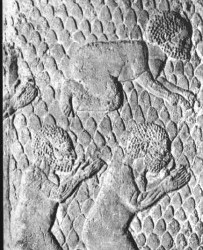
Ancient Hebrews of Lachish
Introduction: According to the standard Jewish Encyclopaedia 96% of all the Jews known to the world today are the descendants of the Khazar tribes of Russia, eastern Europe and western Mongolia; these are the Ashkenazi Jews, the other major sect of the Jews are the Sephardic jews, and they are a bastard people from the mixing of the Canaanites, Hittites, Amorites, Perizzites, Hivites, Jebusites, Girgashites, Kenites, Edomites and some true Israelites. the Jews have never been Isrealites; they are not Israelites now; and they will never be Israelites.
Encyclopedia Americana (1985):
“Ashkenazim, the Ashkenazim are the Jews whose ancestors lived in German lands…it was among Ashkenazi Jews that the idea of political Zionism emerged, leading ultimately to the establishment of the state of Israel…In the late 1960s, Ashkenazi Jews numbered some 11 million, about 84 percent of the world Jewish population.”
The Jewish Encyclopedia:
“Khazars, a non-Semitic, Asiatic, Mongolian tribal nation who emigrated into Eastern Europe about the first century, who were converted as an entire nation to Judaism in the seventh century by the expanding Russian nation which absorbed the entire Khazar population, and who account for the presence in Eastern Europe of the great numbers of Yiddish speaking Jews in Russia, Poland, Lithuania, Galatia, Besserabia and Rumania.”Khazar: Ashkenazi Modern Jew
The Encyclopedia Judaica (1972): The Universal Jewish Encyclopedia: The Universal Jewish Encyclopedia:
“Khazars, a national group of general Turkic type, independent and sovereign in Eastern Europe between the seventh and tenth centuries C.E. During part of this time the leading Khazars professed Judaism…In spite of the negligible information of an archaeological nature, the presence of Jewish groups and the impact of Jewish ideas in Eastern Europe are considerable during the Middle Ages. Groups have been mentioned as migrating to Central Europe from the East often have been referred to as Khazars, thus making it impossible to overlook the possibility that they originated from within the former Khazar Empire.”
The Universal Jewish Encyclopedia:
“The primary meaning of Ashkenaz and Ashkenazim in Hebrew is Germany and Germans. This may be due to the fact that the home of the ancient ancestors of the Germans is Media, which is the Biblical Ashkenaz…Krauss is of the opinion that in the early medieval ages the Khazars were sometimes referred to as Ashkenazim…About 92 percent of all Jews or approximately 14,500,000 are Ashkenazim.”
The Bible: Relates that the Khazar (Ashkenaz) Jews were/are the sons of Japheth not Shem:
“Now these are the generations of the sons of Noah, Shem, Ham, and Japheth: and unto them were sons born after the flood. The sons of Japheth;…the sons of Gomer; Ashkenaz…” (Genesis 10:1-3)
New Standard Jewish Encyclopedia, page 179,[GCP pg 68]
“ASHKENAZI, ASHKENAZIM…constituted before 1963 some nine?tenths of the Jewish people (about 15,000,000 out of 16,5000,000)[ As of 1968 it is believed by some Jewish authorities to be closer to 100%]”
The Outline of History: H. G. Wells,
“It is highly probable that the bulk of the Jew’s ancestors ‘never’ lived in Palestine ‘at all,’ which witnesses the power of historical assertion over fact.”Ancient Hebrews
Under the heading of “A brief History of the Terms for Jew” in the 1980 Jewish Almanac is the following: “Strictly speaking it is incorrect to call an Ancient Israelite a ‘Jew’ or to call a contemporary Jew an Israelite or a Hebrew.” (1980 Jewish Almanac, p. 3).
By
The Bishop
Spread the love
6 notes
·
View notes
Text
Ancient Palestine’s connections to the Greek pantheon 🇵🇸❤️
“[…] the excavations have thrown light upon a far more interesting phase of the early religion of Palestine, namely, the unofficial, everyday religion of the common people. […] figures of Astarte have been found in large numbers.¹ […] The Astarte figures found in southern Palestine, at Lachish, Gezer, etc., are mostly in relief on placques of terra-cotta. It is possible to recognize distinct types: the Phoenician by the prominent hips of the goddess, the Egyptian by the extended arms bearing lotus plants, and others.”- “The Early Religion of Palestine.” Luckenbill, D. D. The Biblical World, vol. 35, no. 6, 1910, pp. 368–79.
“Carried west by Phoenician sailors, Canaanite religious influences can be seen in Greek mythology, particularly in the tripartite division between the Olympians Zeus, Poseidon and Hades, mirroring the division between Baal, Yam and Mot, and in the story of the Labours of Hercules, mirroring the stories of the Tyrian Melqart, who was often equated with Heracles.”- Wikipedia summary of Stories from Ancient Canaan, Second Edition. Reino Unido, Westminster John Knox Press, 2012.
¹ Astarte was often equated with Aphrodite.
May the gods protect the people of Palestine and their land ✊🏼
15 notes
·
View notes
Text
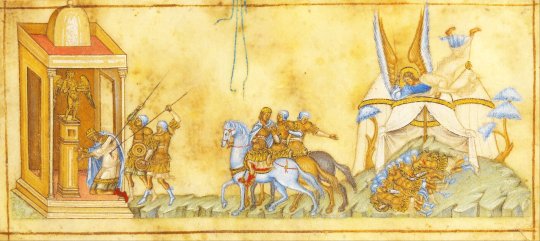
The Assyrians Invade Judah
1 During Hezekiah’s fourteenth year as king, Sennacherib king of Assyria attacked all the strong, walled cities of Judah and captured them. 2 The king of Assyria sent out his field commander with a large army from Lachish to King Hezekiah in Jerusalem. When the commander came near the waterway from the upper pool on the road where people do their laundry, he stopped. 3 Eliakim, Shebna, and Joah went out to meet him. Eliakim son of Hilkiah was the palace manager, Shebna was the royal secretary, and Joah son of Asaph was the recorder.
4 The field commander said to them, “Tell Hezekiah this:
“‘The great king, the king of Assyria, says: What can you trust in now? 5 You say you have battle plans and power for war, but your words mean nothing. Whom are you trusting for help so that you turn against me? 6 Look, you are depending on Egypt to help you, but Egypt is like a splintered walking stick. If you lean on it for help, it will stab your hand and hurt you. The king of Egypt will hurt all those who depend on him. 7 You might say, “We are depending on the Lord our God,” but Hezekiah destroyed the Lord’s altars and the places of worship. Hezekiah told Judah and Jerusalem, “You must worship only at this one altar.”
8 “‘Now make an agreement with my master, the king of Assyria: I will give you two thousand horses if you can find enough men to ride them. 9 You cannot defeat one of my master’s least important officers, so why do you depend on Egypt to give you chariots and horsemen? 10 I have not come to attack and destroy this country without an order from the Lord. The Lord himself told me to come to this country and destroy it.’”
11 Then Eliakim, Shebna, and Joah said to the field commander, “Please speak to us in the Aramaic language. We understand it. Don’t speak to us in Hebrew, because the people on the city wall can hear you.”
12 But the commander said, “My master did not send me to tell these things only to you and your king. He sent me to speak also to those people sitting on the wall who will have to eat their own dung and drink their own urine like you.”
13 Then the commander stood and shouted loudly in the Hebrew language, “Listen to what the great king, the king of Assyria says, 14 The king says you should not let Hezekiah fool you, because he can’t save you. 15 Don’t let Hezekiah talk you into trusting the Lord by saying, ‘The Lord will surely save us. This city won’t be handed over to the king of Assyria.’
16 “Don’t listen to Hezekiah. The king of Assyria says, ‘Make peace with me, and come out of the city to me. Then everyone will be free to eat the fruit from his own grapevine and fig tree and to drink water from his own well. 17 After that I will come and take you to a land like your own—a land with grain and new wine, bread and vineyards.’
18 “Don’t let Hezekiah fool you, saying, ‘The Lord will save us.’ Has a god of any other nation saved his people from the power of the king of Assyria? 19 Where are the gods of Hamath and Arpad? Where are the gods of Sepharvaim? They did not save Samaria from my power. 20 Not one of all the gods of these countries has saved his people from me. Neither can the Lord save Jerusalem from my power.”
21 The people were silent. They didn’t answer the commander at all, because King Hezekiah had ordered, “Don’t answer him.”
22 Then Eliakim, Shebna, and Joah tore their clothes to show how upset they were. (Eliakim son of Hilkiah was the palace manager, Shebna was the royal secretary, and Joah son of Asaph was the recorder.) The three men went to Hezekiah and told him what the field commander had said. — Isaiah 36 | New Century Version (NCV) The Holy Bible, New Century Version®. Copyright © 2005 by Thomas Nelson, Inc. Cross References: Deuteronomy 12:2; 1 Kings 4:25; 1 Kings 13:18; 1 Kings 20:23; 2 Kings 7:6; 2 Kings 17:6; 2 Kings 18:7; 2 Kings 18:11; 2 Kings 18:13; 2 Kings 18:17,18 and 19; 2 Kings 18:27; 2 Chronicles 32:15; 2 Chronicles 32:18; Ezra 4:7; Psalm 146:3; Proverbs 9:7-8; Isaiah 22:5; Isaiah 37:10-11; Jeremiah 36:24
#Assyria#Sennacherib#northern kingdom fallen#invasion#Judah#Isaiah 36#Book of Isaiah#Old Testament#NCV#New Century Version Bible#Thomas Nelson Inc.
8 notes
·
View notes
Text
Five to One
Joshua 10:1-4 Now it came to pass, when Adonizedek king of Jerusalem had heard how Joshua had taken Ai, and had utterly destroyed it; as he had done to Jericho and her king, so he had done to Ai and her king; and how the inhabitants of Gibeon had made peace with Israel, and were among them; That they feared greatly, because Gibeon was a great city, as one of the royal cities, and because…

View On WordPress
#Adonizedek#Eglon#Gibeon#Gibeon was the target#Hebron#Jarmuth#Joshua 10:1-4#king of Jerusalem#Lachish#league against Joshua
0 notes
Text


Gold foil of equestrian Goddess with lotus flowers Tell ed-Duweir, Palestine / Tel Lachish, Israel c. 1200 BC Source: The Many Faces of the Goddess by Izak Cornelius, 2008
Ashtart? Anat?
#astarte#ashtart#anat#goddess#egypt#egyptian gods#canaan#canaanite gods#phoenicia#phoenician gods#aram#aramean gods#syria#syrian gods#levantine gods#mesopotamia#mesopotamian gods#pagan gods#polytheism#archeology#magic#witchcraft#witchblr#paganblr#occult
18 notes
·
View notes
Text
The Lachish Reliefs
The Lachish reliefs are a set of Assyrian palace reliefs narrating the story of the Assyrian victory over the kingdom of Judah during the siege of Lachish in 701 BCE and carved between 700 and 681 BCE, as a decoration of the South-West Palace of Sennacherib in Nineveh, or modern Iraq.
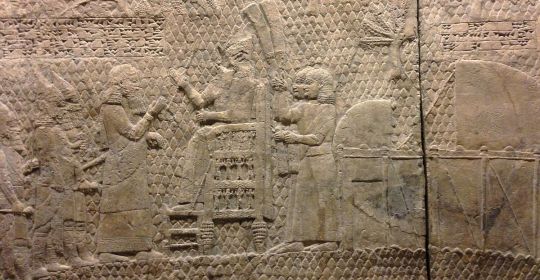
The reliefs were discovered in 1845–1847 fully covering the walls of the palace at 12 metres (39 ft) wide and 5.10 metres (16.7 ft) long.
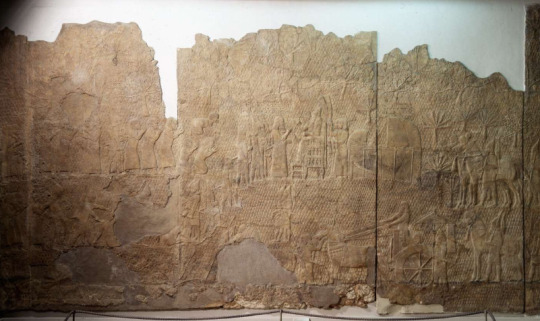
This battle is attested to many times within the Hebrew Old Testament, in Isaiah 36:1-2: "In the fourteenth year of King Hezekiah, King Sennacherib of Assyria came up against all the fortified cities of Judah and captured them. The king of Assyria sent the Rabshakeh from Lachish to King Hezekiah at Jerusalem, with a great army. He stood by the conduit of the upper pool on the highway to the Fuller’s Field." (NRSV) and in 2 Chronicles 32:9: "After this, while King Sennacherib of Assyria was at Lachish with all his forces, he sent his servants to Jerusalem to King Hezekiah of Judah and to all the people of Judah that were in Jerusalem..." (NRSV).
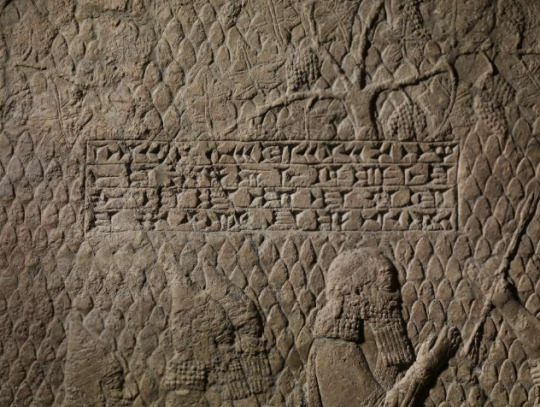
8 notes
·
View notes
Text







Happy Birthday! (March 18th)
Cyber (Pop’n Music)
Simon Penn-Lachish (Final Fantasy Tactics)
Kaname Ohgi (Code Geass)
Winters Socalo (D.Gray-man)
Rei (Gintama)
Yoshiko (Master Detective Archives: RAIN CODE)
Dom (Animal Crossing)
#birthday#march 18#popn music#final fantasy tactics#code geass#d gray man#gintama#master detective archives: rain code#mdarc#animal crossing#final fantasy
3 notes
·
View notes
Text
Canaanite stone tripod—Lachish, now Israel/Palestine, 1780-1580 BCE

There is not much more information about this object on the Met's website.
2 notes
·
View notes